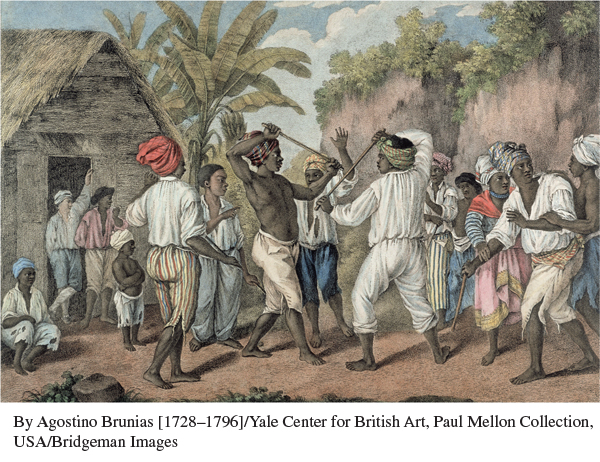A History of Western Society: Printed Page 640
A History of Western Society, Value Edition: Printed Page 613
A History of Western Society, Concise Edition: Printed Page 638
Chapter Chronology
Revolutionary Aspirations in Saint-Domingue
On the eve of the French Revolution, Saint-Domingue — the most profitable of all Caribbean colonies — was even more rife with social tensions than France itself. The colony, which occupied the western third of the island of Hispaniola, was inhabited by a variety of social groups who resented and mistrusted one another. The European population included French colonial officials, wealthy plantation owners and merchants, and poor artisans and clerks. Individuals of French or European descent born in the colonies were called “Creoles,” and over time they had developed their own interests, at times distinct from those of metropolitan France. Vastly outnumbering the white population were the colony’s five hundred thousand enslaved people alongside a sizable population of some forty thousand free people of African and mixed African and European descent. Members of this last group referred to themselves as free people of color.
Legal and economic conditions on Saint-Domingue vastly favored the white population. Most of the island’s enslaved population performed grueling toil in the island’s sugar plantations. The highly outnumbered planters used extremely brutal methods, such as beating, maiming, and executing slaves, to maintain their control. The 1685 Code Noir (Black Code) that set the parameters of slavery was intended to provide minimal standards of humane treatment, but its tenets were rarely enforced. Masters calculated that they could earn more by working slaves ruthlessly and purchasing new ones when they died, than by providing the food, rest, and medical care needed to allow the enslaved population to reproduce naturally. This meant a constant inflow of newly enslaved people from Africa was necessary to work the plantations.
Despite their brutality, slaveholders on Saint-Domingue freed a surprising number of their slaves, mostly their own mixed-race children, thereby producing one of the largest populations of free people of color in any slaveholding colony. The Code Noir had originally granted free people of color the same legal status as whites: they could own property, live where they wished, and pursue any education or career they desired. From the 1760s on, however, the rising prosperity and visibility of this group provoked resentment from the white population. In response, colonial administrators began rescinding the rights of free people of color, and by the time of the French Revolution myriad aspects of their lives were subject to discriminatory laws.

Saint-Domingue Slave Life Although the brutal conditions of plantation slavery left little time or energy for leisure, slaves on Saint-Domingue took advantage of their day of rest on Sunday to engage in social and religious activities. The law officially prohibited slaves of different masters from mingling together, but such gatherings were often tolerated if they remained peaceful. This image depicts a fight between two slaves, precisely the type of unrest and violence feared by authorities.
(By Agostino Brunias [1728–1796]/Yale Center for British Art, Paul Mellon Collection, USA/Bridgeman Images)
The political and intellectual turmoil of the 1780s, with its growing rhetoric of liberty, equality, and fraternity, raised new challenges and possibilities for each of Saint-Domingue’s social groups. For enslaved people, who constituted approximately 90 percent of the population, news of abolitionist movements in France led to hopes that the mother country might grant them freedom. Free people of color looked to reforms in Paris as a means of gaining political enfranchisement and reasserting equal status with whites. The Creole elite, not surprisingly, saw matters very differently. Infuriated by talk of abolition and determined to protect their way of life, they looked to revolutionary ideals of representative government for the chance to gain control of their own affairs, as had the American colonists before them.
The National Assembly frustrated the hopes of all these groups. Cowed by colonial representatives who claimed that support for free people of color would result in slave insurrection and independence, the Assembly refused to extend French constitutional safeguards to the colonies. After dealing this blow to the aspirations of slaves and free people of color, the Assembly also reaffirmed French monopolies over colonial trade, thereby angering Creole planters as well. Like the American settlers before them, the colonists chafed under the rule of the mother country.
Page 641
In July 1790 Vincent Ogé (aw-ZHAY) (ca. 1750–1791), a free man of color, returned to Saint-Domingue from Paris determined to win rights for his people. He raised an army of several hundred and sent letters to the new Provincial Assembly of Saint-Domingue demanding political rights for all free citizens. But Ogé’s demands were refused, so he and his followers turned to armed insurrection. After initial victories, his army was defeated, and Ogé was tortured and executed by colonial officials. Revolutionary leaders in Paris were more sympathetic to Ogé’s cause. In May 1791, responding to what it perceived as partly justified grievances, the National Assembly granted political rights to free people of color born to two free parents who possessed sufficient property. When news of this legislation arrived in Saint-Domingue, the white elite was furious, and the colonial governor refused to enact it. Violence now erupted between groups of whites and free people of color in parts of the colony.
